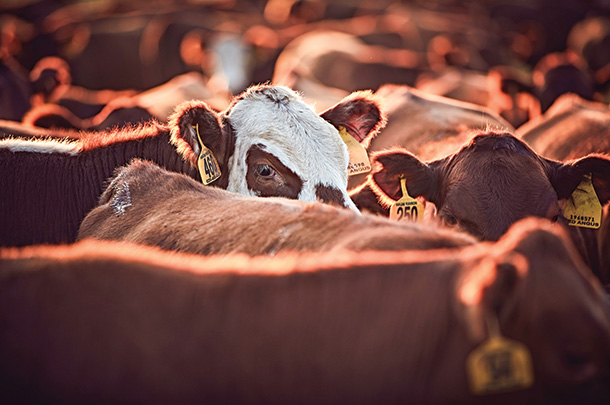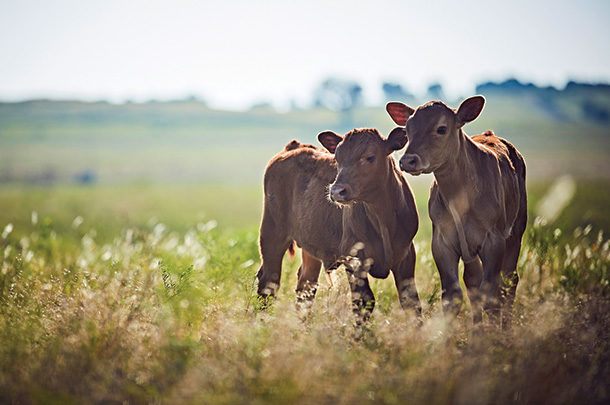A common fallacy among cow-calf producers is that as long as the cow is bred, it doesn’t matter when she calves – but this misconception can be cleared up. Heifers born early in the calving season are more likely to see increased weaning, pre-breeding and pre-calving bodyweights, a greater percentage cycling at the beginning of the breeding season and increased pregnancy rates.
A tighter calving window also allows for grouped nutrition programs, consolidated labor, and more efficient vaccination and deworming schedules.
From a calf marketing standpoint, cattle bring the most money when they all look the same at the time they’re sold. For buyers, that means they can streamline how they feed and manage cattle without having to sort out the big ones from the little ones. Narrowing the calving window means calves are more likely to be of similar ages and weights at the time of sale, and therefore be of higher value to buyers.
 From a calf marketing standpoint, cattle bring the most money when they all look the same at the time they’re sold. Photo courtesy of Boehringer Ingelheim.
From a calf marketing standpoint, cattle bring the most money when they all look the same at the time they’re sold. Photo courtesy of Boehringer Ingelheim.
However, a tighter calving window and more uniform calf crops do not just happen overnight. The good news is there are several ways you can work to fine-tune reproductive programs and reap the benefits of more uniform calf crops for calving seasons to come:
1. Call up your local veterinarian
Every cow-calf operation has unique strengths and weaknesses, which is why consulting your veterinarian is the first step in improving your herd’s reproductive efficiencies. He or she can help you troubleshoot any key issues you’re facing and tailor recommendations to your herd.
2. Ensure heifers are ready for breeding
Take some time to evaluate replacement heifers’ health, nutrition and reproductive status. Reproductive tract scoring and pelvic measurements can be assessed prior to breeding replacement heifers to see if they are reaching puberty and if they should be bred – or if they are more valuable being sold as a market animal.
It is also important to remember that you shouldn’t base your heifer replacements on which heifer is the prettiest in the pen. Instead, these decisions should be based on records. Your best-looking heifer may be the one that has issues with delivering live calves or ends up calving late every year. Early calving cows – and heifers that pass their reproductive exams – are going to help you be successful.
3. Allow for time between breeding soundness exams and bull turnout
A breeding soundness exam provides a quick snapshot of the bull’s reproductive status. Be sure to conduct these exams at least one month prior to the breeding season. This allows for time to make alternative plans if your bull comes back with disease, sperm abnormalities or physical limitations that could render his ability to breed cows effectively.
If you do not conduct a breeding soundness exam until the day the bull is turned out, you may start seeing issues at pregnancy-check time. When you have several open cows that should already be bred at this time, your calving window quickly becomes much wider.
4. Implement a simple synchronization program
Implementing an estrous synchronization program in a cow-calf operation may seem a bit daunting, but it can be a simple move that maximizes profits. In one herd, for example, the first year of synchronization increased the number of cows that calved by the third week by 22%.
Synchronization protocols do not have to be overly complicated; however, you need to be committed to the program to see success. A simple cow-calf herd synchronization program can consist of administering prostaglandin to females five days after the initial bull turnout. With one trip through the chute and a very minimal investment, you can get the bulk of calves born within the first three weeks of the calving season.
More complex protocols may require multiple trips through the chute and the use of gonadotropin-releasing hormone (GnRH). These programs offer additional benefits, and strict adherence to the synchronization protocols is the key to maximizing success. GnRH and prostaglandin products need to be administered using the correct dose, proper technique and timed accurately.
To determine the best synchronization program and products for your herd, consult local experts, create a plan of action and then, when executing the plan, ensure compliance. If you execute a synchronization program effectively, you can create a great deal of value, no matter the size of your operation.
5. Don’t forget about the basics
When I hear of a failed synchronization program, the issue often comes down to a separate aspect of herd management. There are several herd management practices that lay the foundation for reproductive success, including proper nutrition, effective vaccination and parasite control programs, and consistent breeding soundness exams.
You need to invest in what’s most important upfront – having a healthy animal and a good nutrition plan. Then your animals will be cycling more normally, and that will improve your reproductive fertility.
Work with your local veterinarian to ensure your herd is set up for reproductive success.
References omitted but are available upon request by sending an email to the editor.









